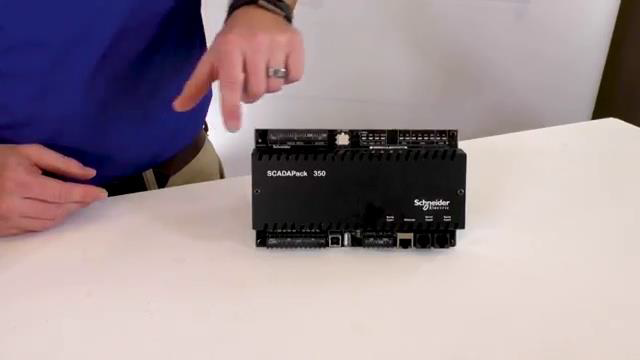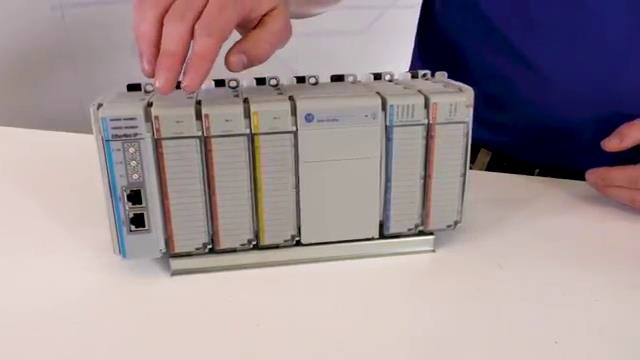Industrial_Control_Panel_In_Depth_Look_Part_4_PLCs_(Programmable_Logic_Controller).pdf
Control Panels (PLC): An in-depth look and what they are and how the function
PLC (Programmable Logic Controller)
- Industrial computer designed to be used in potentially rough environments
- They can withstand heat, cold, humidity, etc.
- Designed to monitor and control and series of "Inputs" and "Outputs"
- Software programs are used to tell the PLC what to do with the data it collects
Common Programming Languages
- Ladder Logic (Visual Programming Language) Based on Relay Logic (Most Common)
- Function Block Diagrams
- Structured Text
- Sequential Function Charts
Typical Hardware
- CPU "Brains of the Operation" (Performs Logic Operations, Control Instructions)
- Memory (Allow the PLC to store data to run the program)
- IO connections points (Where inputs and Outputs get wired)
- Power Supply (Not always required)
- Programming device (Commonly a computer)
Transcript:
[0m:4s] Hi I'm Josh Bloom, welcome to another video in the RSP Supply education series. In today's video, we are going to be talking more about industrial control panels. More specifically, we're going to be taking an in depth look at the heart of the panel that's the PLC or programmable logic controller.
[0m:22s] The PLC is an industrial computer that is designed to be used in potentially rough environments that might be commonly exposed to heat, cold, dust, or moisture.
[0m:34s] They are designed to monitor and control a series of inputs and outputs. The program is running the PLC's evaluate the inputs and change the output signals based on the program response to the input signals. Several programming languages are available to program most PLCs. The most common of these is called ladder logic.
[0m:57s] It is a visual programming language that evolved from relay logic diagrams which visually look like ladders because they consist of two vertical rails with runs between them that contain programmed logic.
[1m:12s] While ladder logic is the most common programming language used within PLCs, there are others that are also common including function block diagrams, or structured text, or sequential function charts. Most PLCs are made up a very similar hardware, though they may be manufactured by different companies. Let's talk about the hardware that typically makes up the PLC. First we have the CPU. This is a microprocessor that acts as the brains of the operation. It will perform logic operations, control instructions, and various other tasks that help keep the PLC running effectively.
[1m:53s] Next, the PLC will have some type of memory. This memory will allow the PLC to store data needed to run the program,
[2m:2s] and also the data that is being collected by the inputs wired to the PLC.
[2m:7s] The PLC will also have a section that is dedicated for IO to be connected, as you can see in these sections here

[2m:16s] on these PLCs.
[2m:17s] This is where the inputs and outputs are actually wired into the PLC itself.
[2m:23s] Depending on the type of PLC you have, this section might be a fixed number of IO points, like you see here,
[2m:30s] or it might be a modular based IO section that allows you to add specific type of IO that you need, which is going to be more like this PLC here.

[2m:40s] Many PLCs require some type of power supply as well. It is common to see more modular based systems integrate this power supply. However, it is not always necessary to use the power supply provided by the original manufacturer of the PLC, and in some cases, the PLC will include a built in power supply so that a separate power supply is not needed at all.
[3m:5s] Lastly, the PLC needs some kind of programming device. This allows you to feed the program into the PLC's memory so that it can perform the desired operation.
[3m:17s] This is most commonly some type of computer. Now that we have a solid understanding of the hardware that makes up the PLC, let's talk about how it actually works. The PLC is designed to run the program repeatedly over and over again, normally many times a second.
[3m:35s] Each time the program runs, the PLC goes through some very specific steps. While the order and the specifics may vary from manufacturer to manufacturer, they all typically follow a pattern similar to the following. First, the PLC performs internal self checks to make sure that it is functioning correctly.
[3m:56s] Secondly, it reads the inputs that are connected to it. It will then store the status of each of those inputs in its memory.
[4m:5s] Then, the PLC will execute the program logic.
[4m:9s] Finally, the PLC will write the new values to the hard wired outputs to match those determined during the program execution.
[4m:18s] At some point in the cycle, communication requests will also be processed.
[4m:24s] Following the execution of the last step,
[4m:27s] the PLC will then cycle back to the beginning of the process and begin all over again.
[4m:32s] Depending on the complexity of the program and the amount of IO, this scan cycle can occur in just milliseconds, allowing the program to run, read the inputs, and react very quickly.
[4m:45s] The speed and reliability of the PLC are some of the main reasons they are ideal for industrial applications.
[4m:52s] Understanding the basic function of the PLC is important but won't always help when purchasing a PLC let's. Look at some things you might want to consider when making this decision.
[5m:3s] When selecting a PLC for your specific application, there are a few things that you typically want to look at to determine that the correct hardware is actually being used. First, we want to make sure that the PLC that we select can handle the IO requirements for your specific application.
[5m:21s] It is good practice to ensure that you have spare IO available in your PLC for future expansion if needed.
[5m:30s] It is also important to consider the environment the PLC will actually be located.
[5m:35s] Most PLCs are designed to operate in temperatures between 32 degrees and 130 degrees Fahrenheit. However, this will vary depending on the manufacturer and many will make hardened versions with wider operating temperature ranges.
[5m:51s] It is also important to determine the CPU and memory requirements of the PLC to make sure it can accommodate the program complexity and required execution frequency of the specific application.
[6m:5s] Lastly, it is important to determine how the PLC will communicate, especially in remote locations.
[6m:13s] Will it be using serial or Ethernet?
[6m:16s] What protocols does it need to be able to communicate with?
[6m:20s] This would be like saying what language does it need to speak to communicate with other devices on the network.
[6m:26s] Having the answers to these questions will make PLC selection much easier. And with these answers, many vendors will be able to help you select the appropriate PLC for your application.
[6m:38s] As you can see, there are a lot that goes into the hardware function and selection of a PLC, and today we have just covered some of the basics.
[6m:47s] For PLC hardware or thousands of other products, please go to our website. For more information or other educational videos, go to RSPSupply.com, the Internet's top source for industrial hardware. Also, don't forget: like and subscribe.




